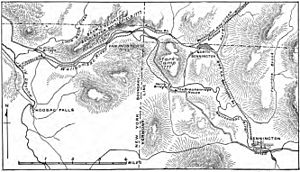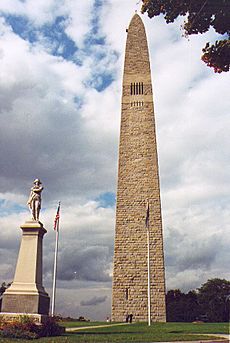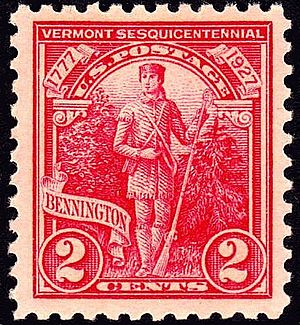Battle of Bennington facts for kids
Quick facts for kids Battle of Bennington |
|||||||
|---|---|---|---|---|---|---|---|
| Part of the American Revolutionary War | |||||||
 A 1780 map depicting the troop positions at the start of the battle |
|||||||
|
|||||||
| Belligerents | |||||||
|
Iroquois |
|||||||
| Commanders and leaders | |||||||
|
|
|||||||
| Strength | |||||||
| 2,000–2,500 (Stark) 350 (Warner) |
800 (Baum) 550–650 (Breymann) |
||||||
| Casualties and losses | |||||||
| 30 killed 40 wounded |
207 killed 700 captured 4 cannons (2–3pdr Baum, 2–6pdr Breymann) lost |
||||||
The Battle of Bennington was an important fight during the American Revolutionary War. It happened on August 16, 1777, near Walloomsac, New York, about 10 kilometers from Bennington, Vermont. American forces, mostly militia (citizen soldiers), led by General John Stark and Colonel Seth Warner, won a big victory. They defeated a group of British and German soldiers led by Lieutenant Colonel Friedrich Baum and Lieutenant Colonel Heinrich von Breymann.
Baum's group had about 700 soldiers. They were a mix of German dragoons (soldiers who rode horses but fought on foot), Canadians, Loyalists (Americans who supported the British), and Native Americans. General John Burgoyne sent them to Bennington to find horses, supplies, and food. Burgoyne thought the town was not well-defended. But he didn't know that General Stark and 1,500 militiamen were already there.
After a rain delay, Stark's men surrounded Baum's position. They captured many soldiers and killed Baum. Then, more soldiers arrived for both sides. The battle started again. Stark and Warner's men fought hard and forced Breymann's soldiers to retreat.
This battle was a huge success for the Americans. It weakened Burgoyne's army by almost 1,000 men. Many Native American allies also left him. He lost important supplies like horses and food. These losses helped lead to Burgoyne's defeat later at the Battle of Saratoga. The victory also made more colonists support independence. It even helped convince France to join the war on the American side. Vermont celebrates the battle's anniversary every year as Bennington Battle Day.
Contents
Why the Battle Happened
British Plans for the War
The American Revolutionary War had been going on for two years. The British decided to change their strategy. They stopped focusing on the rebellious New England colonies. Instead, they wanted to divide the Thirteen Colonies. Their goal was to cut off New England from the southern colonies. The British thought the southern colonies were more loyal to them.
They planned a big attack with three groups moving towards Albany.
- One group from the west failed at the Siege of Fort Stanwix.
- Another group from New York City never started. General William Howe decided to attack Philadelphia instead.
The third group, coming from Canada, had the most success. General John Burgoyne led this northern group. He won battles at Fort Ticonderoga, Hubbardton, and Fort Anne. Burgoyne wanted to capture Albany and control the Hudson River Valley. This would split the colonies in two.
British Army's Challenges
Burgoyne's march towards Albany started well. But by late July, his army slowed down a lot. They had trouble getting supplies. The Americans had destroyed a main road, making things even harder. Burgoyne's supplies began to run low.
In early August, Burgoyne learned that General Howe was going to Philadelphia. This meant Howe would not come up the Hudson River to meet him. Burgoyne became very worried about his supplies.
To get more supplies, Burgoyne sent about 800 soldiers. This group was led by Lieutenant Colonel Friedrich Baum. Their mission was to find horses for the German soldiers. They also needed animals to help move the army's wagons. And they needed to bother the American forces.
Baum's group was mostly German dragoons. They were joined by Loyalists, Canadians, and Native Americans. Baum was first told to go to the Connecticut River valley for horses. But Burgoyne changed his mind. He told Baum to go to a supply depot in Bennington. Burgoyne believed only about 400 American militia were guarding Bennington.
American Forces Gather
Burgoyne did not know that the people of the New Hampshire Grants (now Vermont) had asked for help. They wanted protection from the British army. New Hampshire and Massachusetts responded.
On July 18, New Hampshire allowed John Stark to raise a militia. His job was to defend the people or annoy the enemy. Stark quickly gathered 1,500 militiamen in six days. This was more than 10% of New Hampshire's male population over 16.
Stark's men marched to Manchester. There, Stark met with Seth Warner. General Benjamin Lincoln tried to take control of Stark's men. But Stark refused. He said he only answered to New Hampshire. Stark then went to Bennington with Warner as his guide. Warner's men stayed in Manchester.
Leading Up to the Battle
Baum's Advance
Baum's German soldiers left Burgoyne's camp on August 9. They marched towards Bennington. Along the way, they captured some Americans. From these prisoners, they learned that a large American force was at Bennington.
On August 14, Baum's men met some of Stark's soldiers. Stark's men had been sent to check on reports of Native Americans in the area. Stark's men retreated. They destroyed a bridge to slow Baum down.
When Stark heard about the approaching British, he asked for help from Manchester. Then, he moved his troops out of Bennington. He set up a defensive line to face Baum's force.
Baum sent a message to Burgoyne after the first contact. He said the American force was bigger than expected. But he still thought they would retreat. He moved a few miles closer to Stark's position. Then he realized his first message was wrong. He sent a second message to Burgoyne, asking for more soldiers.
Rain and Reinforcements
It rained for the next day and a half. This stopped the battle from starting. During this time, Baum's men built a small fort on top of a hill. They hoped the bad weather would stop the Americans from attacking. They wanted to wait for their reinforcements to arrive.
Stark sent out small groups of soldiers to check the German lines. They managed to kill thirty Native Americans. This was hard because they had to keep their gunpowder dry in the rain.
On August 15, more soldiers marched for both sides. Travel was very difficult because of the heavy rain. Burgoyne sent 550 men under Heinrich von Breymann. Warner's company of about 350 Green Mountain Boys came south from Manchester.
Late on August 15, Stark was woken up by Parson Thomas Allen. Allen was with a group of Massachusetts militiamen. They insisted on joining Stark's force. Stark told them to rest and be ready for the next day.
Stark's forces grew to almost 2,000 men. This included some Stockbridge Indians. Baum's force also grew by almost 100 men. A group of local Loyalists arrived in his camp on the morning of August 16.
The Battle Begins
On the afternoon of August 16, the weather cleared. Stark told his men to get ready to attack. He reportedly told his troops they were fighting for their rights. He pointed to the British and Loyalists and said, "They are ours, or this night Molly Stark sleeps a widow."
Baum thought the Americans were retreating. He saw the militia moving into the woods. But Stark was actually sending groups to attack the sides of the German lines. The Americans used a trick to get closer. German soldiers had been told that Loyalists wore white paper in their hats. Stark's men also put white paper in their hats. This helped them get closer without being fired upon.
The fighting began around 3:00 PM. Stark described the gunfire as "the hottest engagement I have ever witnessed." The German position was quickly surrounded. The Loyalists and Native American positions were taken over. Many of them ran away or surrendered.
This left Baum and his German dragoons alone on the hill. The Germans fought bravely. They ran low on gunpowder. Their ammunition wagon was destroyed. In desperation, the dragoons charged with their swords. They tried to break through the American lines. But the charge failed badly. Many German soldiers were killed. Baum was badly wounded in this last charge. The remaining Germans surrendered.
Breymann's Arrival
After the battle, Stark's militiamen were busy disarming prisoners. They were also taking supplies. Then, Breymann arrived with his reinforcements. He saw the Americans were disorganized. He immediately attacked.
Stark's forces quickly regrouped. They tried to hold their ground against the new German attack. But they started to fall back. Just before their lines broke, Warner's men arrived. They reinforced Stark's troops. The intense fighting continued until dark. Both sides then stopped fighting. Breymann began a quick retreat. He had lost a quarter of his men and all his cannons.
What Happened Next
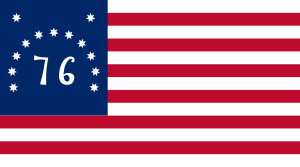
The British and German forces lost many soldiers at Bennington. About 207 were killed and 700 were captured. The Americans lost 30 killed and 40 wounded. The fighting was very harsh, especially when Loyalists fought Patriots. This was because they sometimes came from the same towns. The captured soldiers were sent to Boston.
Burgoyne's army was getting ready to cross the Hudson River. This was on August 17. Then, news of the battle arrived. Burgoyne thought he might need to send more soldiers. He marched his army towards Bennington. But then he heard that Breymann and his remaining men were returning. More stragglers arrived throughout the day and night. News of the disaster spread through the camp.
The Battle of Bennington had a big impact on Burgoyne's plan. He had lost almost 1,000 men. Half of these were regular soldiers. He also lost important support from Native Americans. Many of the Native Americans who had traveled with him decided to go home. This made it much harder for Burgoyne to scout the area.
He also failed to get needed supplies. This meant he had to rely on supply lines that were already too long. These lines eventually broke in September. The lack of supplies was a major reason he surrendered at Saratoga. After that, France joined the war against Britain.
American Patriots were very happy about the news of the battle. After Burgoyne's Native American scouts left, small groups of Patriots started to bother British positions. Many of Stark's men went home. But some returned to help surround Burgoyne's army at Saratoga in October.
John Stark received a reward from New Hampshire. It was a complete suit of clothes. He also received a message of thanks from John Hancock. Hancock was the president of the Continental Congress. This message included a promotion for Stark to "brigadier in the army of the United States."
Soldiers in the Battle
The groups of soldiers involved in the battle are listed below. The numbers for Breymann's troops can vary in different historical records.
United States and Vermont Troops
|
British and German Troops
|
Remembering the Battle
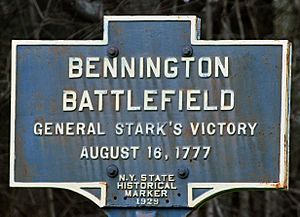
August 16 is a legal holiday in Vermont. It is called Bennington Battle Day. The battlefield is now a New York state historic site. It was named a National Historic Landmark on January 20, 1961. It was also added to the National Register of Historic Places on October 15, 1966.
In the 1870s, a local history group in Bennington decided to build the Bennington Battle Monument. It was finished in 1889 and opened in 1891. President Benjamin Harrison attended the opening. The Monument is a tall, pointed tower called an obelisk. It is 306 feet (93 meters) high. It is also listed on the National Register of Historic Places.
Every year on Bennington Battle Day, the Molly Stark Cannon is fired. This is the oldest firing cannon in the United States. It was captured during the Battle of Bennington.
See also
 In Spanish: Batalla de Bennington para niños
In Spanish: Batalla de Bennington para niños


